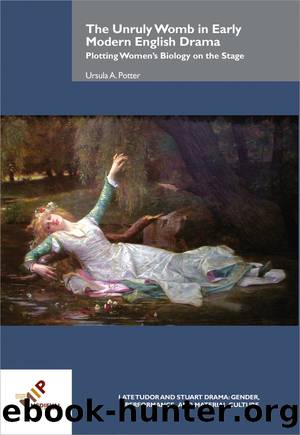The Unruly Womb in Early Modern English Drama by Ursula A. Potter

Author:Ursula A. Potter [Potter, Ursula A.]
Language: eng
Format: epub
Tags: History, Europe, Medieval, Drama, Renaissance, Literary Criticism, General, Medical, Religion, Christianity, Protestant, Ancient & Classical, Shakespeare
ISBN: 9783110662016
Google: i9G1DwAAQBAJ
Publisher: Walter de Gruyter GmbH & Co KG
Published: 2019-04-01T01:08:02+00:00
Chapter 7
The Maidâs Tragedy (1611â1613) and Parasitaster, or The Fawne (1604â1606)
IN THE SAME YEAR The Two Noble Kinsmen was staged, another play on the theme of precarious virginity was performed. This was The Maidâs Tragedy, written by John Fletcher and Francis Beaumont, and presented at the court of James I as part of the wedding celebrations of two royal teenagersâJamesâs daughter, Princess Elizabeth and Frederick V, Count Palatine of the Rhine.1 The bride and groom were each only sixteen years old. The play opens by discussing a âgreat matchâ about to take place and a masque to celebrate it, so it must have appeared self-referential at the time of its performance, whether or not it had been written earlier as has been conjectured.2 It was one of several plays performed during the course of the lengthy marriage celebrations (February to April 1613), but given the themes of broken betrothals, bridal night failure, sexual exploitation, and betrayal, it seems an extraordinary choice of play, particularly if it was performed on the wedding day: February 14, Valentineâs Day. Yet this play is possibly only exceptional in that it is a tragedy. By tradition, plays and masques written for weddings focused on the wedding bed and consummation. They usually praised the brideâs beauty, her virtues, and her bashfulness, whereas the groom was fair game and was expected to âendure the short scorne of a Bridegroomes play,â as Donne claims in Loveâs Alchymie. Furthermore, Donne claims that,
That loving wretch that sweares,
âTis not the bodies marry, but the minds,
Which he in her Angelique finds,
Would sweare as justly, that he heares,
In that dayes rude hoarse minstralsey, the spheares.3
In alerting us to a tradition of ârude hoarse minstralseyâ (the forerunner of todayâs âstag nightâ bachelor parties) the poet appears to be refuting âthat loving wretchâ Shakespeare, who wrote of the marriage of true minds in Sonnet 116. Donneâs own contribution to this particular royal wedding, âAn Epithalamion, or Marriage Song on the Lady Elizabeth and Count Palatine Being Married on St. Valentineâs Day,â is an exercise in comic titillation drawn out over eight stanzas. The poem dwells first on the frustratingly slow progress of the bride to the bedchamber, then the negotiation of the unclothing, and finally to her lying on the bed awaiting the groom who, in stanza 6, has his own impediments to surmount:
But now she is laid; what though shee bee?
Yet there are more delayes, for, where is he?
He comes and passes through Spheare after Spheare,4
First her sheetes, then her Armes, then any where.
Stanza 7 completes the act, as âvery quickly they pay their debtâ again and again, and so moves to the court onlookers who âneare you whispering speake, / and wagers layâ on which of the newlyweds will first open the curtains at break of day.5 Evidently, wedding poems and plays were written explicitly to celebrate the sexual initiation of the bride and the loss of her maidenhead, while the groom had to endure some scorn. A key component of The Maidâs
Download
This site does not store any files on its server. We only index and link to content provided by other sites. Please contact the content providers to delete copyright contents if any and email us, we'll remove relevant links or contents immediately.
| Ancient & Classical | Anthologies |
| British & Irish | Children's |
| Comedy | LGBT |
| Medieval | Regional & Cultural |
| Religious & Liturgical | Shakespeare |
| Tragedy | United States |
| Women Authors |
Cecilia; Or, Memoirs of an Heiress — Volume 2 by Fanny Burney(31871)
Cecilia; Or, Memoirs of an Heiress — Volume 3 by Fanny Burney(31852)
Dialogue by Robert McKee(4321)
The 101 Dalmatians by Dodie Smith(3452)
Bound by Hatred (The Singham Bloodlines Book 2) by MV Kasi(3024)
The Art of Dramatic Writing: Its Basis in the Creative Interpretation of Human Motives by Egri Lajos(3015)
Harry Potter and the Cursed Child - Parts One and Two by John Tiffany(3003)
The Beautiful Boys: A High School NA Reverse Harem Paranormal Bully Romance (Shadowlight Academy Book 1) by Gow Kailin(2828)
Angels in America by Tony Kushner(2595)
Carrie's War by Nina Bawden(2431)
A Clockwork Orange by Anthony Burgess(2414)
Unlaced by Jaci Burton & Jasmine Haynes & Joey W. Hill & Denise Rossetti(2325)
The Femme Playlist & I Cannot Lie to the Stars That Made Me by Catherine Hernandez(2247)
Open Book by Jessica Simpson(2204)
Drama by John Lithgow(2189)
Outside Woman (BWWM Amish Romance) by Stacy-Deanne(2083)
Terrorist Cop by Mordecai Dzikansky & ROBERT SLATER(2036)
Yerma by Federico García Lorca(2016)
Leo's Desire by Sundari Venkatraman(1897)
